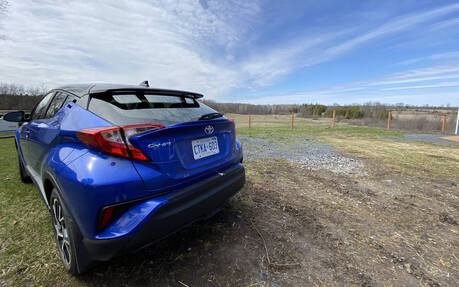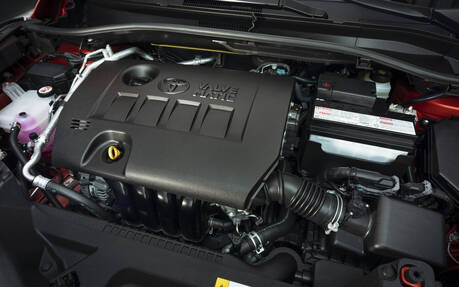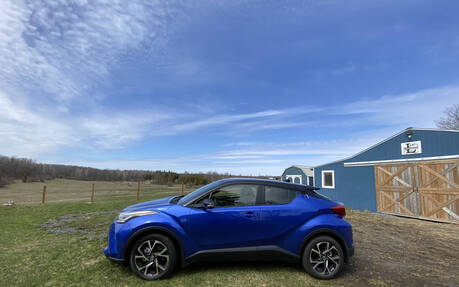2022 Toyota C-HR: Looks Aren't Everything
It’s true: We consume mostly with our eyes. First impressions are main in seconds the moment our eyes land on any given object. How does it make us feel as soon as we look at it? Is it attractive? Repulsive? Funny? Scary? Looks carry a huge amount of weight in terms of something’s likability and longevity.
When the Toyota C-HR first emerged a few years ago, the initial reaction was: Well, that’s different for Toyota. And it was. Most recently, before the C-HR the most exciting design to roll off the Toyota production lineup was the sporty Celica… Truthfully, beginning with the C-HR, Toyota started to really revamp its overall model lineup look. They’ve taken a drastic turn towards more aggressive and modern exterior designs,and while it might seem shocking it has breathed a bit more new life into all of their vehicles.
- Also: Small SUVs Remain a Big Source of Dissatisfaction
- Also: 2021 Toyota C-HR Adds Nightshade Edition, Still No AWD

What does C-HR stand for?
It’s not often that vehicle naming actually means something when it comes to random letters and numbers. However, in this case, Toyota took the time to actually create an acronym that meant something.
According to the Japanese automaker, C-HR stands for “Compact High Rider” or “Cross Hatch Run-About.” Both make perfect sense because that’s essentially what the Toyota C-HR is. A compact vehicle that rides slightly higher and is great for running about the city and other suburban/urban settings.
They definitely named this little suburban runner appropriately. And while it might not be as high as a proper crossover or SUV, it definitely sits a little above a compact sedan or hatchback, which is rather nice.
A Run-Around-Town Type
What we really wished the C-HR had was a manual transmission. Yes, yes, we know: It’s going the way of the dodo bird, but it makes a huge difference in how a vehicle feels on the road, especially a vehicle that’s not necessarily hugely powerful or sporty. Which the C-HR isn’t. Just like the stickshift in the Toyota Corolla made it feel perkier and more fun to drive, I feel the same would be felt in the C-HR.

Equipped with a 2.0L inline-4, the C-HR produces 144 horsepower and 139 lb-ft of torque. Not a whole lot. And with the automatic transmission, the entire thing just felt a little anemic, which is a shame. This little compact high-rider could be just as much fun to pilot as a Nissan Micra (which has even less horsepower and torque) if it had a different transmission. Just saying.
Standing out from the Crowd
Now, if there’s one thing the C-HR does extremely well it’s be different. This is one of those cars that instantly polarizes people because of how it looks. Now, is that a good thing? We aren’t too sure.
Toyota has taken its exterior designs to extremes as of late, and while it seems like a good idea to possibly excite a younger generation and turn them on to the brand, at the same time it has the potential to ostracize your core community of loyal followers.
Now, luckily, the buyer for the C-HR is not the same as the Camry, so the aggressive lines and looks of the cross hatch run-about are slightly more appealing. But, it’s just not the prettiest thing on the road - in our opinion. The colour palette available for the C-HR is also quite extensive, and with the option to differentiate the colour of the roof from the body it allows the buyer to really personalize the vehicle.
You can bring that exterior flare inside the vehicle as well, with available coloured options that can have that same bright blue blaze across the dash. It’s shocking at first, but it definitely grew on me as the week progressed. Would I love it forever? Likely not. But it is a nifty little design element.

Living Larger than It Looks
We were also rather impressed with the interior space of the C-HR. What looks to be a small vehicle on the outside translates into a much larger space inside. Even the trunk is decent with 538 litres behind the rear seats. Now, the rear seats can be a little more restrictive depending on the height of the occupant seated in front of them, and the shape of the rear door windows limit visibility for some passengers (shorter) from looking outside.
Up front, there’s typical Toyota HMI and H-VAC system controls that are easy to use and hook up in terms of Apple CarPlay and Android Auto.
Overall, the Toyota C-HR is a fabulous choice as a first car or second family vehicle. However, with the introduction of the Corolla Cross, its days may be numbered.
| Test drive report | |
| Test model | 2022 Toyota C-HR |
|---|---|
| Trim level | XLE Premium |
| Price range | $24,150 – $29,350 |
| Price as tested | CA$26,750 |
| Warranty (basic) | 3 years/60,000 km |
| Warranty (powertrain) | 5 years/100,000 km |
| Fuel economy (city/highway/observed) | 8.7 / 7.5 / 8.8 L/100km |
| Options | N/A |
| Competitive models | Buick Encore, Chevrolet Trax, Hyundai Venue, Kia Soul, Mazda CX-3, Nissan Kicks |
| Strong points |
|
| Weak points |
|
| Editor's rating | |
| Fuel economy | We expected better from such a small vehicle with an equally small engine |
| Comfort | Decent space up front, but the rear seats feel cramped because of the window shape |
| Performance | Can get loud under heavy acceleration without the speed to back it up |
| Infotainment | While easy to use, it looks dated |
| Driving | Pretty hum-drum: not terrible, but not great either |
| Overall | As a first car, this is a great choice, but the Corolla Cross will hurt the C-HR's popularity |